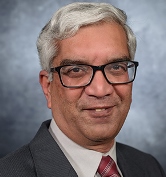
Two information systems professors at the Naveen Jindal School of Management have helped create an award-winning answer to the riddle of how to provide the best healthcare in an age of malpractice lawsuits.

Information Systems Ashbel Smith Professor Srinivasan Raghunathan and Assistant Professor Mehmet Ayvaci won a best paper award in November from the eBusiness section of INFORMS (the Institute for Operations Research and the Management Sciences). They won the award for “When IT Creates Legal Vulnerability: Not Just Overutilization, But Underprovisioning of Health Care Could Be a Consequence,” a study that proposes to use more flexible guidelines in determining which patients should take a test and using these guidelines as part of clinical-decision support.

The paper’s two other co-authors were Yeongin Kim, a JSOM 2018 PhD in Management Science alumnus now at Virginia Commonwealth University, and Turgay Ayer of the Georgia Institute of Technology.
“We are extremely glad to see the INFORMS eBusiness section’s recognition of this research. The award encourages us to pursue our efforts in uncovering overlooked or unintended consequences of healthcare information technologies,” Raghunathan said.
Physicians’ fear of litigation has “a double-sided adverse effect on healthcare,” he said. “It contributes to overutilization in some cases, while simultaneously contributing to underutilization in some other cases.”
As healthcare guidelines for treating patients have grown longer, more rigid and more accessible in IT systems, they are often used as evidence in malpractice lawsuits, Ayvaci explained.
“Defensive medicine is a huge issue for the U.S. healthcare system,” he said. “If there’s a litigation risk, doctors are sometimes going to overdo it and, for example, recommend more biopsies,” he said.
As a result, healthcare providers have been locked in a long-running debate over just how strict guidelines embedded in IT systems should be. Using game theory models, the paper’s authors weighed various factors and concluded that, in certain cases, creating more flexible guidelines is the best possible solution to providing high-quality healthcare amid the ever-present risk of a lawsuit.
As electronic health records become more ubiquitous, the debate over how to best design healthcare guidelines and incorporate them into IT systems is only going to get louder, Ayvaci said.
“In the age of big data, risk-prediction models are getting more precise in terms of telling us the likelihood of developing a disease,” he said. “On the one hand, it’s solving problems through better predictions, but on the other hand, it’s exacerbating problems such as defensive medicine. With this paper, we’re contributing to the debate and offering one solution among multiple different solutions.”





